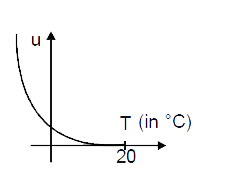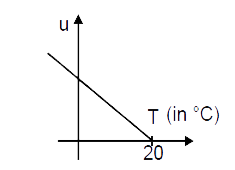A metal wire is clamped between two vertical walls. At 20∘C the unstrained length of the wire is exactly equal to the separation between walls. If the temperature of the wire is decreased the graph between elastic energy density (u) and temperature (T) of the wire is




The correct Answer is:B
To solve the problem, we need to analyze the behavior of the metal wire when its temperature is decreased. The wire is initially unstressed at a temperature of 20∘C and its length is equal to the separation between the two vertical walls.
1. Understanding Initial Conditions:
- At 20∘C, the wire is unstressed, meaning it is at its natural length, which is equal to the distance between the two walls.
2. Effect of Temperature Decrease:
- When the temperature of the wire decreases, the wire will contract due to thermal contraction. This means that the length of the wire will decrease.
3. Constraints Imposed by the Walls:
- Since the wire is clamped between the two walls, it cannot contract freely. As the temperature decreases and the wire tries to contract, it will experience tensile stress because it is held in place by the walls.
4. Elastic Energy Density:
- The elastic energy density u in the wire is related to the stress and strain in the wire. As the wire is forced to remain at the length of the walls while trying to contract, it will store elastic potential energy.
5. Graph of Elastic Energy Density vs. Temperature:
- As the temperature decreases, the elastic energy density u will initially increase because the wire is under increasing tension (stress) due to the constraints of the walls.
- The graph will show an increase in u as T decreases, indicating that the wire is storing more elastic energy as it is forced to remain at a fixed length while trying to contract.
6. Conclusion:
- The graph of elastic energy density u versus temperature T will slope upwards as the temperature decreases, indicating an increase in elastic energy density due to the tensile stress in the wire.
- At 20∘C, the wire is unstressed, meaning it is at its natural length, which is equal to the distance between the two walls.
- When the temperature of the wire decreases, the wire will contract due to thermal contraction. This means that the length of the wire will decrease.
- Since the wire is clamped between the two walls, it cannot contract freely. As the temperature decreases and the wire tries to contract, it will experience tensile stress because it is held in place by the walls.
- The elastic energy density u in the wire is related to the stress and strain in the wire. As the wire is forced to remain at the length of the walls while trying to contract, it will store elastic potential energy.
- As the temperature decreases, the elastic energy density u will initially increase because the wire is under increasing tension (stress) due to the constraints of the walls.
- The graph will show an increase in u as T decreases, indicating that the wire is storing more elastic energy as it is forced to remain at a fixed length while trying to contract.
- The graph of elastic energy density u versus temperature T will slope upwards as the temperature decreases, indicating an increase in elastic energy density due to the tensile stress in the wire.
Topper's Solved these Questions
- BOOK - MOTIONCHAPTER - ELASTICITY AND THERMAL EXPANSIONEXERCISE - Exercise -1 (Section C - Youngs Modulus, Poissions Ratio)4videos
ELASTICITY AND THERMAL EXPANSION
- BOOK - MOTIONCHAPTER - ELASTICITY AND THERMAL EXPANSIONEXERCISE - Exercise -1 (Section D - Thermal Expansion (Solid , Liquids & Gas) & types, Applications (Ex Bimetallic strip etc))4videos
ELASTICITY AND THERMAL EXPANSION
- BOOK - MOTIONCHAPTER - ELASTICITY AND THERMAL EXPANSIONEXERCISE - Exercise -1 (Section A - Stress & types, Strain & types + Types of Modulus + Energy Problems + Graphs)6videos
ELASTICITY AND THERMAL EXPANSION
- BOOK - MOTIONCHAPTER - ELASTICITYEXERCISE - EXERCISE -360videos
ELASTICITY
- BOOK - MOTIONCHAPTER - Electrical Instrument EXERCISE - EXERCISE -316videos
Electrical Instrument
Similar Questions
Knowledge Check
- Question 1 - Select One
Assertion : The drift velocity of electrons in a metallic wire will decrease, if the temperature of the wire is increased.
Reason : On increasing temperature, conductivity of metallic wire decreases.AIf both assertion and reason are ture and reason is the correct explanation of assertion.BIf both assertion and reason are true but reason is not the correct explanation of assertion.CIf assertion is true but reason is false.DIf assertion and reason both are false. - Question 2 - Select One
Assertion : The drift velocity of electrons in a metallic wire will decrease, if the temperature of the wire is increased.
Reason : On increasing temperature, conductivity of metallic wire decreases.AIf both assertion and reason are ture and reason is the correct explanation of assertion.BIf both assertion and reason are true but reason is not the correct explanation of assertion.CIf assertion is true but reason is false.DIf assertion and reason both are false. - Question 3 - Select One
A constant voltage is applied between two ends of a metallic wire. If the length is halved and the radius of the wire is doubled, the rate of heat developed in the wire will be:
AIncreased 8 timesBDoubledCHalvedDUnchanged
The top of two vertical poles of height 20m and 14m are connected by a wire. If the wire makes an angle 30∘ with the horizontal, then the length of the wire is
View SolutionResistance of a metal wire of length 1 m is 26Ω at 20∘C. If the diameter of the wire is 0.3 mm, what will be the resistivity of the metal at that temperature?
View SolutionFor an elastic stretched wire, the ratio of its elastic potential energy and the energy density of the wire is equal to
View SolutionA constant voltage is applied between the two ends of a metallic wire . If both the length and the radius of the wire are doubled , the rate of heat developed in the wire will
View SolutionA constant voltage is applied between the two ends of a metallic wire. If both the length and the radius of the wire are doubled, the rate of heat developed in the wire
View Solution

